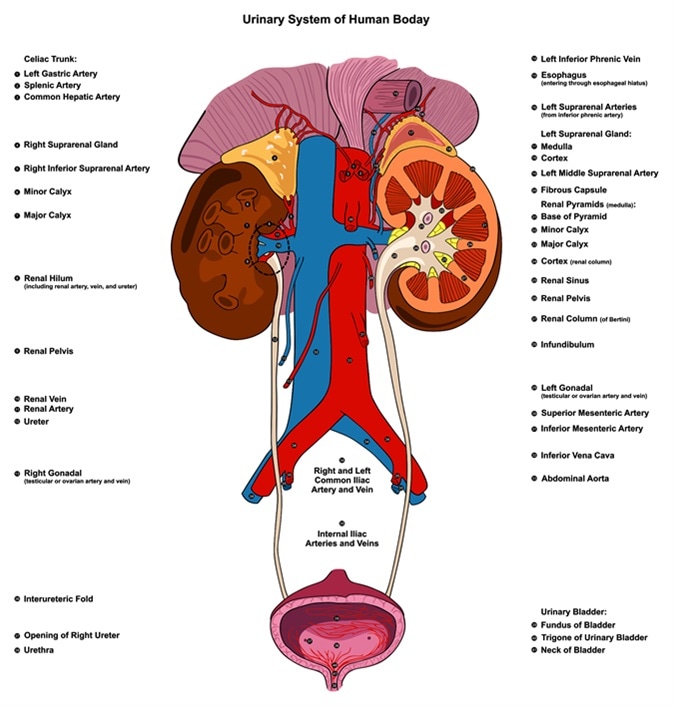By Jeyashree Sundaram (MBA)
Urine is composed of fluid and waste materials; it is discharged by the urinary tract, which is the drainage system of the body. If all body parts in the urinary tract coordinate and function appropriately, then urination takes place in a natural manner.

Urinary Renal System of Human Body Anatomy - Image Credit: Udaix / Shutterstock
Kidneys
They are two fist-sized bean-shaped organs, one of which is on either side of the spine, beneath the rib cage.
When we consume food and fluids, the body utilizes the nutrients for maintaining body functions and leaves behind the waste products in the bowel and blood. Urea—a form of waste product—is collected from the blood and moved to the kidneys. In the kidneys, small filtering units known as nephrons are present. These nephrons comprise small blood capillaries in the form of a ball known as a glomerulus and a tiny tube known as a renal tubule. The wastes deposited in the body, including urea and water, produce a fluid called urine, which is passed out of the body through nephrons.
The kidney filters around 120 to 150 quarts of blood daily to generate around 1 to 2 quarts of urine. The kidney functions continuously; no individual can restrict its actions. The levels of chemicals such as potassium, sodium, phosphorus, and calcium in the body are balanced by kidneys. The acidity of the blood is checked by kidneys. They also produce certain hormones which help to increase the production of red blood cells and control blood pressure and aid in the development of strong bones.
Ureters
These are fine tubes made up of muscles; they are located on either side of the bladder and carry urine to the bladder from the kidneys. Ureters comprise two tubes which are thin and approximately 8–10 inches in length. Ureter walls continuously tighten and relax the muscles of the ureter and this action forces the urine to pass downward. The ureters empty urine into the bladder in small amounts at intervals of 10–15 s.
Bladder
This is a balloon-shaped, hollow, muscular organ located between the pelvic bones in the pelvis. It tends to expand when filled up with urine. No individual can restrict kidneys’ actions, but an individual is in full control while emptying the bladder i.e., during urination.
Urine is stored in the bladder until it gets excreted. In healthy individuals, 1.5 to 2 cups of urine can be accumulated in the bladder, which acts as a storage unit for about 2–5 h. Generally, the need for a person to urinate relies on how rapidly urine is produced and fills the bladder. The bladder wall's muscle stays flexible when the bladder is filled with urine and a person tends to urinate when the bladder is completely filled. The urethra is located at the base of the bladder, through which the bladder gets emptied on urination. When the bladder is filled, it takes a round shape, and becomes smaller upon completion of urination. In men, the opening portion of the urethra is located at the end of their penis. In women, the opening of the vagina acts as the urethral opening.
The amount of urine produced in a person is affected by the following factors:
- Amount of liquid and solid food consumed, and the quantity of fluid draining out through breathing and sweating.
- A few medical conditions, food type, and medications.
- The individual's age. Generally, urine produced in adults is higher than that in children.
Importance of the Urinary Tract
Three sets of muscles function together like a reservoir, keeping the urine in the bladder until it is discharged by the person. The urethra is the first set of muscles, and the bladder neck is the place where the urethra meets the bladder. The bladder neck aids in holding urine in the bladder, which is made up of the second set of muscles called the internal sphincter. The pelvic floor muscles are also termed as the external sphincter; they are the third set of muscles which encircle and assist the urethra. Muscular bladder walls receive signals from the brain, upon which the bladder stiffens and discharges the urine out of the body during urination. The sphincters also receive signals from the brain to stay relaxed. Once the sphincters relax, urine passes out of the bladder through the urethra.
Infections of the Urinary Tract
Bacteria are not present in the urine. As the urine flows out (one way), infections are prevented. When the urine is retained in the kidneys due to some medical conditions or if it moves back to kidneys from the bladder, bacteria may enter the urine causing a urinary tract infection (UTI) in the individuals. On an average, 8.1 million people are affected by a UTI annually. Statistics show that approximately 1 out of 25 women and 3 out of 25 men show a minimum of 1 UTI symptom in their lifetime.
Further Reading